Tongiaki
Tongiaki (Originalregel)
Game preparation
With /join 2-6 players can join the game. The game begins with /start. Alternatively, you can use the game management.
The game

Tongiaki is playing 300 years AD: players explore up to 16 islands on daring sailing trips. You start on your home island of TONGA. As the game progresses, players place more and more ships on the beaches of the islands. As soon as a beach is completely occupied by ships, the ships set off for new shores. To do this, an ocean card is usually revealed and laid out. The players receive points at the end of the game for all islands on which they are represented with at least one ship.
Gameplay< /span>
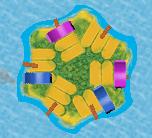
At the beginning of the game, players are allowed to deploy two ships each on TONGA.

Whoever's turn it is always has the choice between three possible moves:
- Increase (almost always)
- Become king (rarely)
- Repopulate (almost never)
Proliferate
The red ship in the magnifying glass shows the “Propagate” action. The active player clicks on an island that has at least one of his ships on it and multiplies there. He deploys as many ships of his color on this island as there are already ships of his color on the island - but at most as many as the island has beaches. He may place a maximum of one ship on each beach of this island.
Become king
The native mask in the magnifying glass shows the action "Become King". The active player clicks on an island that has at least one of his ships and no other ships on it, and becomes king there. The island then only counts for him at the end of the game. This island may no longer be entered by any player. A player is allowed to found a maximum of two royal islands per game.
Repopulation
Sometimes it can happen that a player emigrates unluckily pretty isolated and hopeless on one or a few islands. To ensure that the game is not decided in favor of the opponent right from the start, there is the option of repopulating. To do this, the active player can, instead of making a normal move (multiply or king), take all of his ships off the board (King's Islands remain occupied!) and dare to start anew. To do this, he sets his ship on a new island. To do this, he chooses the symbol of the crossed island in the magnifying glass. He now reveals cards and places them in a specific place on the game board until he has found an island. On this he places a ship on any beach.
Consequences of reproduction
Reproduction and its consequences are the fundamental ones Moves of this game
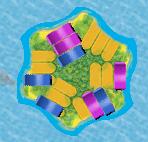
If no beach on the island is full after an increase, the turn ends and it is the next player's turn.
But if at least one beach is complete, all ships on this beach set sail (emigration).
Emigration
The player clicks on the jetty on the beach ( more precisely: the area of the beach where the jetty points) where the ships should first set sail. He can always start in any order. Different footbridges extend from the beaches in different directions. If there is already a card in the desired direction, no new card is revealed.
If the player reveals a water card or emigrates via a water card that is already on display, the ships move along the white foam trail across the ocean. However, such a trip is only successful if the required number of different colors travel in the group of ships. The number on the foam trail indicates the danger of the route:
| no number | crossing always succeeds | 2 | at least 2 different colors required |
| 3 | at least 3 different colors required | < /tr>
| 4 | at least 4 different colors required |
If the crossing is successful, the player covers another ocean card on. This happens until the ships either reach an island or a crossing fails. If the crossing fails, the ships are removed from the plan and returned to their owners.
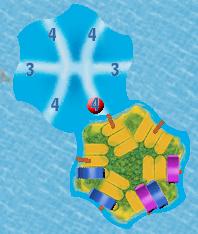
Here in the picture, the upper beach was emigrated with two colors. Since a 4 was revealed, the crossing was not successful.
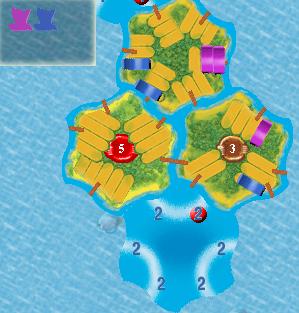
This was from the two-person beach of the three-person island emigrated to the bottom right. Since the lower jetty of the two-person beach was selected, the water card was revealed first. Since the two had two colors on the foam trail, the crossing was successful and another card was revealed, this time the five-card island.
Landing
Does the revealed card show an island or lead it When emigrating to an island card that is already on display, the active player distributes all emigrating ships to the beaches of the new island. He first places a ship on each beach if there are enough available. If there are any more ships left, he can distribute them as he wishes across the beaches. If there are not enough free berths available, the surplus ships are returned to their owners. The distribution of ships when landing on a card that is already on display works in the same way.
Chain train
After During the landing and distribution of the emigrated ships, all berths on one or more beaches may be occupied. Then the player has his turn and starts emigrating again. The chain pull continues until no beach is completely occupied.
Special case of King's Island
All ships that try , to land on a King's Island, move back and land on the island from which they came. TONGA cannot become a king's island.
End of game
The game ends as soon as the last water card or the last island card is revealed and placed (i.e. if there are 16 water cards or 16 island cards on the table). The active player's turn is still being carried out, after which the game is over.
If the last card is an island, the landing still takes place on it.
If the last card is a water card, the ships still set sail.
Now all players receive their points: for each island they are on If at least one ship is represented, they receive the island value. The player with the most points wins. If two or more players have the same number of points, the one who has distributed their ships on the most islands wins. If it is still a tie, the player with the fewest ships (Queen Islands count as one ship) on the game board is the winner.
Data display
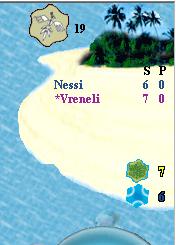
The game data is displayed on the island at the top right of the picture.
Behind each game name you can see the number of ships in the supply as well as the victory points achieved ( the latter only after the end of the game).
Below you can see the number of water or island cards that have already been laid out. The draw pile is represented by the gray island space to the left of the palm trees.
Special situations
< p> Rare cases are now treated here. It is not necessary to read this before playing the first game. It should serve as a reference.No ship on the board
If there is no ship on the board at the start of his turn, The active player must place two ships on TONGA or one ship on another island.
All ships on the game board
If all 15 ships of a player are on the game board at the start of the turn, the player may take any ship from an island in order to multiply with it. However, he is only allowed to take one even if he is actually allowed to use several to multiply.
Too few ships?
If a player is allowed to use more ships than he has in front of him when multiplying, he can only use the available ships.
Infinite chain pull
< p> A chain pull is considered infinite if it cannot be resolved by a finite combination. This can happen if an island is surrounded exclusively by maps that lead back to the island. Then all ships on this island will be removed and returned to their owners. The island card is removed from the game.If this means that there is not a single revealed island left on the game board or< /span>
- if the active player has got all of his ships back through this action,
he turns over ocean cards until an island comes up . The player may place any revealed water cards and the island anywhere on the cards on display.
With the game material available in the game Tongiaki, such a situation is only possible on a single island (it will recognized by the program and treated accordingly). On a group of islands, a chain pull is never infinite. However, there are cases that can only be solved with several moves.
Click areas
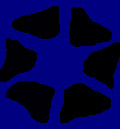
You can see on the left in the picture the click areas to click when setting sail. So you click on the part of the island that corresponds to the direction.
If you place ships on wider beaches, you still always click on the middle of the beach, even if only the edge areas are free are. The ships are then automatically assigned a free beach spot.

